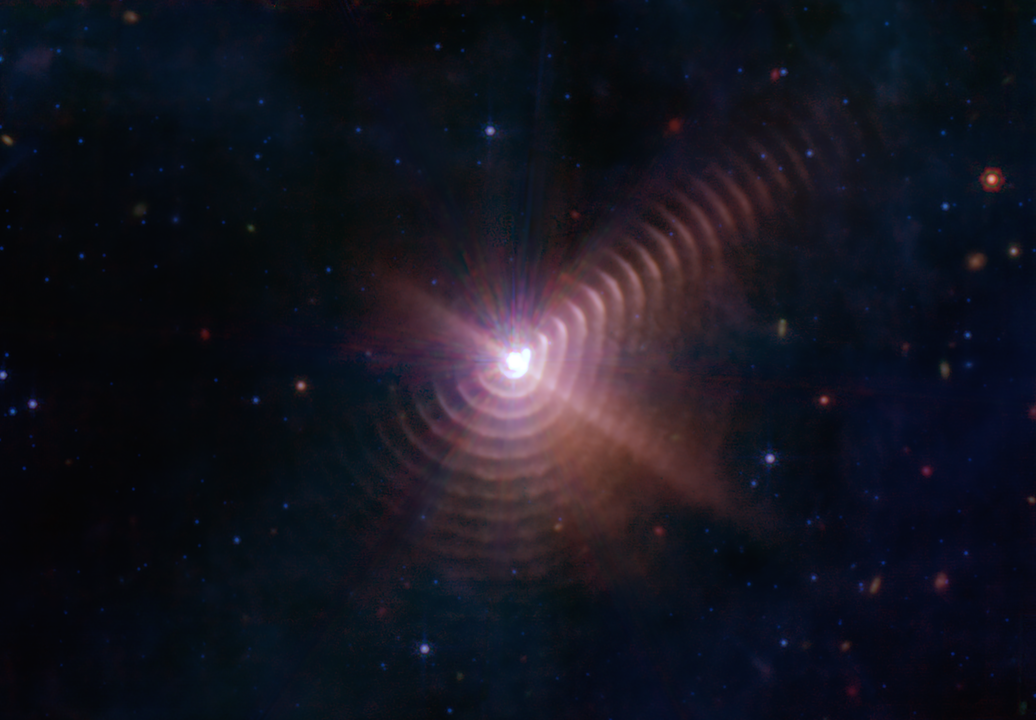Wolf-Rayet 140 - MIRI Image

About This Image
Description:
The latest image from NASA's James Webb Space Telescope is a new perspective on the binary star Wolf-Rayet 140, revealing details and structure in a new light. Astronomer Ryan Lau of NSF's NOIRLab, principal investigator of the Webb Early Release Science program that observed the star, shares his thoughts on the observations. "On the night that my team's Early Release Science observations of the dust-forming massive binary star Wolf-Rayet (WR) 140 were taken, I was puzzled by what I saw in the preview images from the Mid-Infrared Instrument (MIRI). There seemed to be a strange-looking diffraction pattern, and I worried that it was a visual effect created by the stars' extreme brightness. However, as soon as I downloaded the final data I realized that I was not looking at a diffraction pattern, but instead rings of dust surrounding WR 140 - at least 17 of them
"I was amazed. Although they resemble rings in the image, the true 3D geometry of those semi-circular features is better described as a shell. The shells of dust are formed each time the stars reach a point in their orbit where they are closest to each other and their stellar winds interact. The even spacing between the shells indicates that dust formation events are occurring like clockwork, once in each eight-year orbit. In this case, the 17 shells can be counted like tree rings, showing more than 130 years of dust formation. Our confidence in this interpretation of the image was strengthened by comparing our findings to the geometric dust models by Yinuo Han, a doctoral student at the University of Cambridge, which showed a near-perfect match to our observations. "One of the biggest surprises was how many shells the telescope was able to detect. The shells furthest from the binary star have traversed over 70,000 times the distance from Earth to the Sun, at speeds of around 6 million miles per hour, through the harsh environment around a WR star-some of the hottest and most luminous stars known. The survival of these distant shells shows that the dust formed by WR binaries like WR 140 will likely survive to enrich the surrounding interstellar environment. However, it wasn't enough for us to see these dusty shells. We wanted to know their spectroscopic signature and chemical composition. What will they add to the interstellar medium?
"With the Medium-Resolution Spectroscopy (MRS) mode on MIRI, we obtained the first spatially resolved mid-infrared spectra of a dust-forming WR binary in our observation of WR 140, and were able to directly probe the chemical signatures of its dust shells. Broad and prominent features in the spectral lines at 6.4 and 7.7 microns told us that the dust was composed of compounds consistent with Polycyclic Aromatic Hydrocarbons (PAHs). This carbonaceous material plays an important role in the interstellar medium and the formation of stars and planets, but its origin is a long-standing mystery. With the combined results of JWST's MRS spectra and MIRI imaging, we now have evidence that WR binaries can be an important source of carbon-rich compounds that enrich the interstellar environment of our galaxy, and likely galaxies beyond our own."
| About The Object | |
|---|---|
| Object Name | WR 140 |
| Object Description | Wolf-Rayet Star |
| R.A. Position | 20:20:27.98 |
| Dec. Position | +43:51:16.28 |
| Constellation | Cygnus |
| Distance | 5,600 light-years |
| Dimensions | Image is about 2 arcmin across (about 3 light-years) |
| About The Data | |
| Data Description | This image was created from JWST data from proposal: 1349 of JWST |
| Instrument | JWST>MIRI |
| Filters | F770W, F1500W, F2100W |
| About The Image | |
| Color Info | These images are a composite of separate exposures acquired by the James Webb Space Telescope using the MIRI instrument. Several filters were used to sample different infraraed wavelength ranges. The color results from assigning different hues (colors) to each monochromatic (grayscale) image associated with an individual filter. In this case, the assigned colors are: Red: F2100W Green: F1500W Blue: F770W |






